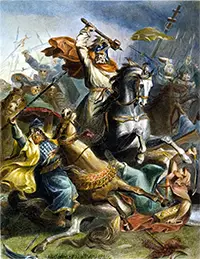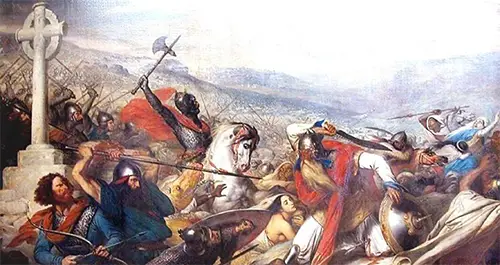The Battle of Tours
The Battle of Tours was a battle between Frankish and Muslim armies in what is now France in 732. 
The Prophet Muhammad had died in 632, and Islamic armies set out to conquer the world around them. They took over Northern Africa, what parts of it belonged to Rome, and then crossed the Mediterranean Sea and, in 711, invaded what is now Spain. Twenty years later, an army under Abd al-Rahman al-Gafiqi was prepared to cross the Pyrenees. In June 732, the Muslim army stormed into Aquitaine, defeated the defending army, and burned the capital, Bordeaux. The leader of Aquitaine, Eudes, fled north, imploring the Frankish strongman Charles Martel to help him regain his land. Martel agreed and marched at the head of a large army to Tours, a city on the Aquitaine border. There, he waited. Meanwhile, the Muslim army took to marauding around the countryside. 
Three months of that was enough to convince Al-Rahman that it was time to move on to Tours, where he knew the Frankish army was. Al-Rahman's armed force was large, much larger than what the Franks could bring to bear. As well, the Muslim fighters featured a large contingent of heavy cavalry. The Muslim army arrived at Tours but did not attack right away. In fact, neither side made any major move to attack for a solid week, while temperatures got colder. Historians think that the Frankish army had, at its height, 20,000 soldiers and that the Muslim army had more, perhaps 25,000 men. (Sources differ on the exact totals of both forces. Sources generally agree that the Franks were outnumbered.) Al-Rahman had finally had enough and, on what many historians say was October 10, 732, launched an attack. The Muslim force sent multiple waves of cavalry charging at the assembled Frankish defenders, mostly infantry, most without armor. The Frankish wall, augmented by a phalanx-like formation that occupied the high ground in a forested area, held, long enough for Eudes and his Aquitainian cavalry to ride around the Muslim flank and attack from the rear. The surprise flanking maneuver was enough to give the attackers pause and, in fact, drove them to flight. Another factor in the sudden retreat was the widespread belief shared by many Muslim soldiers that it was only a matter of time until their opponents figured out a way to storm the Muslim camp and steal food, weapons, and other items. The Aquitanian flanking maneuver convinced many Muslim soldiers to put down their arms and race back to the camp. The ones who didn't break and flee Al-Rahman and nearly half of his army died in the fighting, their leader while trying to stop the retreat. Frankish losses numbered about 1,500. It was a strategic and a symbolic victory for Charles Martel and the Franks. As it turned out, Muslim armies never again invaded over the Pyrenees. |
|
Social Studies for Kids
copyright 2002–2024
David White




